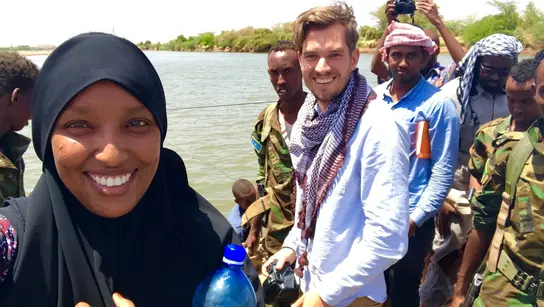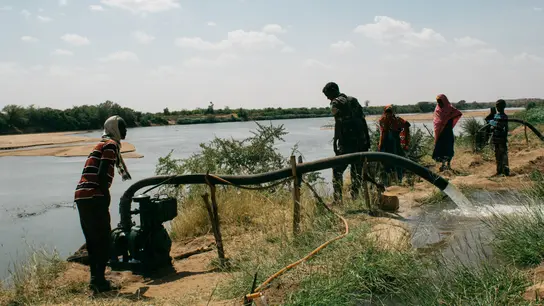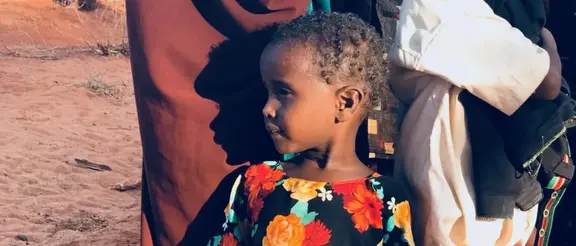Interview about Terre des Hommes aid projects
Marti Gensel works in the Humanitarian Aid department at Terre des Hommes . When people in our project countries find themselves in extreme distress due to natural disasters such as floods, droughts, or earthquakes, he ensures rapid assistance. But he is also concerned with preventing a natural event from becoming a human catastrophe. For this reason, he visited the Gedo region in East African Somalia, which borders Kenya and Ethiopia. At the end of 2018, a project was launched here with financial support from the German Federal Ministry for Economic Cooperation and Development (BMZ), which benefits five communities each in Somalia and Kenya. It is helping people prepare for the recurring and increasingly extreme droughts. Iris Stolz spoke with Marti Gensel about the project, the omnipresent threat posed by the Islamist terrorist militia Al-Shabaab, and the situation of women and children.
Mr. Gensel, why were you in Somalia?
We have been working in the Gedo region for five years. When the extreme drought was in spring 2017 and threatened to starve people, we distributed food and water together with our partner organization Napad in the Kenyan-Somal border region. Napad stands for "Nomadic Assistance for Peace and Development". Now we want to start a larger project. It is about the fact that people are permanently protected from hunger and can deal with the recurring drought period. I was there to clarify: what is needed most, what do we do where?
Dürren always existed. Has the extent got worse?
Yes. The lifeline of the region, the River Juba, leads less and less water and the dry periods are getting longer - a consequence of climate change. This has dramatic effects: cattle shepherds have to sell their animals or sell far below value, and sufficient foods cannot be grown. The floors are basically fertile, but if there is no water there, of course nothing grows.
What does Terre des Hommes want to do?
If at the time in which the river leads water, enough foods can be produced and stored, the drying phase can also be better survived. But the question is: how do you get the water on the fields? We want to support the municipalities in watering their fields more effectively and improving their drinking water supply. We want to install pumps and irrigation systems so that the harvest yields can be increased - both for self -sufficiency and for the market. In some villages there are already pumps. However, they are usually operated with gasoline. To do this, a municipality has to apply an average of $ 200 a month. If there is no money, no water flows either.


What does Terre des Hommes want to improve?
We plan to install solar pumps. Fortunately, there is no shortage of solar energy in Somalia. I saw pumps that have been working for six years and are cared for and cared for by the village community. You have recognized: This is about our livelihood.
Is the water from the river drunk too?
Yes. There are also a few fountains. When the river and the fountains lie dry, most people survive through the so -called "water trucking": trucks come, loaded with drinking water. Sometimes the aid organizations organize. Often, however, these are dealers who sell the water. For this water, people must temporarily pay 15 times the price, which is otherwise due on public fountains.
"They walk through the villages and take what they need"
Is Islamist al-Shabaab active in the project region?
It is one of the regions that are not controlled by the al-Shabaab but by the Somali government, but attacks still happen at regular intervals. Most of them are directed against government structures and their employees.
Where did you get your weapons from?
They obviously find their way. In Somalia it is said: We have often lacked foods on weapons and ammunition. I was told that the trailers pull through villages and take what they need. There are no security structures that could prevent this.
How do the children get along with this situation?
The children only know this condition. Many have to hunger, and because there are hardly any health stations and medical care, around 135 of 1,000 newborns do not even experience their fifth year of life. Somalia is also the country with the highest rate of genital mutilation: 98 percent of women who are currently between 15 and 49 years old were subjected to a procedure - almost 80 percent of them between the ages of five and nine. And finally: school education is of poor quality and the school enrollment is low. In many regions, much less than half of the children attend a primary school - not to mention further education.
And the fear of violence ...
... is certainly a constant companion. The boys have to fear being recruited by the militias or the military. Many are forced, some go for lack of alternatives. In the Somali schools there are the typical letter walls: A like Airplane, B for Banana etc. In some schools, Airplane was replaced by A for ammunition, i.e. the English word for ammunition. I was explained that Airplanes do not know the children. Ammunition lies around everywhere.
What influence do women have?
That is very different. I visited two villages in one day. In the first, women only dared to take the word after a long time. I experienced the following 20 kilometers further: When we arrive, men and women are already sitting under a tree together. After talking two men, a woman speaks confidently. In the first sentence, she says: what the men say here is everything nonsense. And she was right! We have found that what women show as needs usually make sense. This experience also shows how immensely it is that we work with partner organizations that know the conditions on site. Knowledge of the role of women in the individual communities can, for example, decide on failure or success of projects. That is why it is important to us to include women in our projects and strengthen their self -confidence.
